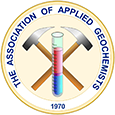Patrice Lavergne
1929-2013
Pat Lavergne was one of the unsung heroes of applied geochemistry, he worked at the Geological Survey of Canada for 50 years, retiring in 1997, and died in August at the age of 84. He was one of the first employees hired by Hal Steacey (later Curator of the National Mineral Collection) to work in the Radiometric Laboratory of the GSC’s Mineral Deposits Division, September 20, 1947. At that time the search was for uranium deposits, his task was to scan samples submitted by prospectors and the public with a Geiger counter to identify those that were uraniferous. Pat’s later, and major work, after he joined the recently formed Geochemistry Section in 1960, was in sample preparation, an often unacknowledged task, working over the years on all the materials in the geochemist’s catalogue. What he excelled at were mineral separations, he could perform incredible feats with his heavy liquids, modified Superpanner and Frantz separator. This was particularly valuable to the mineral studies of both Bob Boyle and Ian Jonasson for over 35 years. Pat was the only Survey employee to receive a 50 year service gold-plated medal and citation signed by the Prime Minister of Canada. It was presented to a very shy and embarrassed Pat at a special meeting on his retirement, October 1, 1997. He was seen to bite it, just to make sure it was gold. He retired a month later, he had achieved his goal.
There was not a single GSC geochemist or mineral deposit geologist that did not benefit from his quiet diligence and inventiveness working in the background to support our research studies. His lab contained a collection of equipment accumulated over the years, much of which he had modified to improve its performance or make it easier to clean so as to avoid cross-contamination. He wrote two excellent papers to impart his very specialized knowledge of sample preparation and mineral separation. He preferred to work quietly away on the top, eighth, floor of the Geological Survey building on Booth Street. The 1988 Open File is a complete set of instructions for establishing a sample preparation facility in the lab or field that is still a valuable contribution today. Behind the scenes he contributed to hundreds of papers and Open File reports by the Ottawageoscientists.
As an example of Pat’s versatility and inventiveness there is the story of the refrigerator rescued from the Whitehorse, Yukon, dump in 1965 for use in Operation Keno led by Chris Gleeson and Bob Boyle. Why the refrigerator was rescued is lost to history, but Pat got it up to Keno Hill and running again in its propane mode, where it was used to keep the dithizone cold and away from light to be used each day for the Bloom (1955) field test for heavy metals in stream sediments and waters. At the end of the field season it was shipped back to Ottawa where it continued to work in its electrical mode. In the late 1960s it was in the Room 733, the Section meeting room, being used to keep lunches, and the like, cold. Eventually it found its way to the Operations Room on the fifth floor. It continued to run until 2007 before it finally died, probably after some 50 years of service. Pat was contacted, but a second resuscitation proved impossible. They simply don’t make them like they used to. And the same can be said of Pat Lavergne.
Thank you Pat for your dedication and all the work you did for the Ottawa geochemists.
Bob Garrett and Ian Jonasson,
Geological Survey of Canada
Ottawa, Ontario.
Bibliography:
BLOOM, H. 1955. A field method for the determination of ammonium citrate-soluble heavy metals in soils and alluvium. Economic Geology, 50, 533-541.
LAVERGNE, P.J. 1965. Field and Laboratory Methods used by the Geological Survey of Canada in Geochemical Surveys - No. 8 Preparation of Geological Materials for Chemical and Spectrographic Analysis. Geological Survey of Canada, Paper 65-18, 23 p.
LAVERGNE, P.J. 1988. Field and Laboratory Methods used by the Geological Survey of Canada in Geochemical Surveys: Preparation of Geological Materials for Chemical and Spectrochemical Analysis; Separation and Concentration of Minerals; and a Guide to the Identification of Common Minerals. Geological Survey of Canada, Open File 1428, 57 p.
